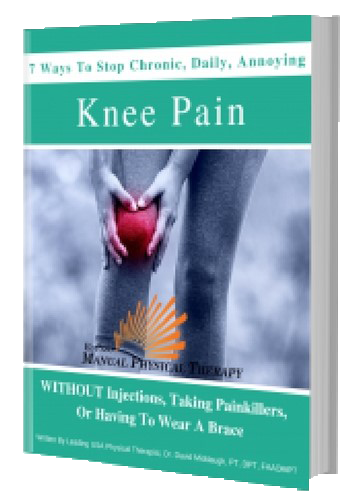TAP TO CALL (915) 503-1314

TOP 8 REASONS FOR A CHRONIC LIMP AFTER KNEE REPLACEMENT SURGERY
I’ve got the top eight reasons for a chronic limp after a knee replacement surgery, number one is pain. If your knee is painful every time you go to step on it, well, it might cause you to limp. That’s your body’s response, telling you that there’s something wrong in your knee, and it can’t support your bodyweight every time you take a step. So you need to listen to that and make sure that you take care of the pain.
Number two is loose hardware in your knee. I mean the parts that were installed, whenever your knee replacement was done, where the metal is installed, and it’s attached to the bone, on the end, that way was shaved off on both the thigh bone and the top of the shin bone.
If you have issues with it, and the hardware starts to loosen, that could cause you to limp, maybe chronically, sometimes it hurts, and sometimes it does not. Another reason for instability is loose ligaments in your knee.
Whenever you have the knee replacement done, they often still preserve some of the ligaments in your knee joint, and they’re relying on those ligaments in your knee to hold your knee together well.
But if you have an issue that causes loosening of the ligaments that could also cause some instability, which might contribute to a chronic limp. And before we get into the rest of the reasons for limping, let me just take a quick moment to ask you to subscribe.
YouTube’s telling us that only 11.6% of people watching our videos are actual subscribers. And I don’t want you to miss any of the helpful information that we post every week, so that you can catch all the information, make sure you hit the subscribe button and turn on the notification bell so that we pop up on your home feed and we probably notifications in case this is especially important for you.
Number three is a learned limp. If this happens when you don’t have any pain, you don’t have an instability, you really don’t have much of a problem. The issue is that you never got over the limping, you just got into a habit of limping, you walk with a little bit of a shift like this towards the side that you had operated on. And it’s just a matter of realizing that you limp and why you’re limping and maybe even seeing yourself in a mirror.
And then you have to consciously think about fixing it making sure that you don’t limp that you don’t let your body tip over every time you take a step that can sometimes be the fix for a chronic limp.
Number four is not using a cane or a walker, using something like a cane can help you to not limp as much it may be that you don’t have enough strength in your leg. And taking some of the weight off with a cane might help you to be straighter and that can save other joints, like your hips, your lower back your ankles, your feet, your other knee from becoming painful. If a cane isn’t enough support, then you might need to be using something like a walker to get even more support so that you’re not limping whenever you walk.
It’s okay to go back to using a walker if you were using a cane previously, because the limping could cause issues in other joints, and it could even affect the knee joint replacement, the hardware that was installed, you don’t want to have to redo that surgery. Number five is thigh muscle weakness.
Here in the leg, you have the thigh muscles, the quads on the front and then the hamstrings on the back and you have some other muscles around there, the groin muscles and some muscles on the outer part. Those muscles are typically weak right after surgery like within the first two to three months. And if you don’t have enough support from those muscles, it could be that every time you step your legs is going to want to give a little bit and you might limp.
That’s why you’re told to use the walker at the beginning, of course a cane if appropriate for you. As you get stronger in those thigh muscles, it should be much easier to support your weight and reduce the limping. These same thigh muscles tend to get stronger immediately relative to other muscles, which takes me to number six, glute muscle weakness. I’m talking about the muscles in the back of the hip, the butt muscles.
Those are really important to get strong because if you once you have thigh muscle strength, then you need to control it with the glutes, the glutes are very involved in controlling the position of the thigh bone, which affects the knee joints. And if you don’t have good glute strength, then it’s likely that you can get into a position where your thigh muscles are controlling the position of the knee. And this can cause you to step inappropriately cause pain and limp chronically.
Getting more glute strength assists you in better control of your knee, which puts you in a position to stop limping chronically. Number seven is foot muscle weakness. Down here in the foot you have muscles that support the arch of the foot.
And if you got weak after surgery, or worse yet, if you had weakness even before the surgery in your foot muscles, then it’s possible that your flat footed, your arch collapses down when you step and every time you collapse the arch you can see up here in the knee joint, that knee moves inwards, that little motion right there can also contribute to a chronic limp, which can cause pain in the knee joint as well.
And so getting the muscles that support the arch stronger down here in the foot can make a huge difference in improving In a chronic limp. And number eight is muscle imbalances. Now, this kind of ties together the weaknesses that I’ve been talking about already the glute muscle weakness, specifically in the foot muscle weakness.
These muscle imbalances can cause excessive pressure and tension to go through the knee joint and other structures around the knee joint like the tendons, the ligaments, some of the bones as well, the interface between the metal and the bone. All of those things can be affected and can be sources of pain, which can then contribute to the first point that I made how pain can make you limp.
Fixing the muscle imbalance is critical in order to make sure that all the strength is appropriate to the hip, the knee, the foot, and the balance of forces, the mechanical forces going through your replaced knee is normalized so that you can walk as straight as possible. Ideally, you don’t even want people to know that you had a knee replacement, it should look like you’re walking completely normal.
I talk extensively about correcting muscle imbalances in those that have had knee replacements right here on this channel, you can find help if you’re dealing with a painful knee replacement or muscle imbalances. If you want to learn more about that through a playlist that I put together for you. It’s called the Knee Replacement Pain Help playlist, and it’s linked down in the description below.
I’ve also made an online program called the Failed Knee Replacement Recovery Program that goes in depth on how to fix these muscle imbalances as well as other problems related to knee replacements that can cause some chronic pain. There’s a link for that down below where you can learn more too.
Hey, thanks so much for watching this video. If you thought it was helpful for you, please give us a thumbs up share this with somebody that you think needs to hear this chances are this was shared with you, so return the favor by sharing it with somebody else who’s never heard of this concept, because you might be changing their lives. And don’t forget to subscribe and turn on our notification bell so that you don’t miss out on any of our videos. Thanks so much for watching. I’ll see you in the next video. Bye bye!
Would You Like To Talk With A Specialist?
Appointments and Questions Call: (915)503-1314
EL PASO MANUAL PHYSICAL THERAPY
2601 E. Yandell Drive, Suite 232
El Paso, Texas 79903
© 2023 El Paso Manual Physical Therapy, PLLC, All Rights Reserved
